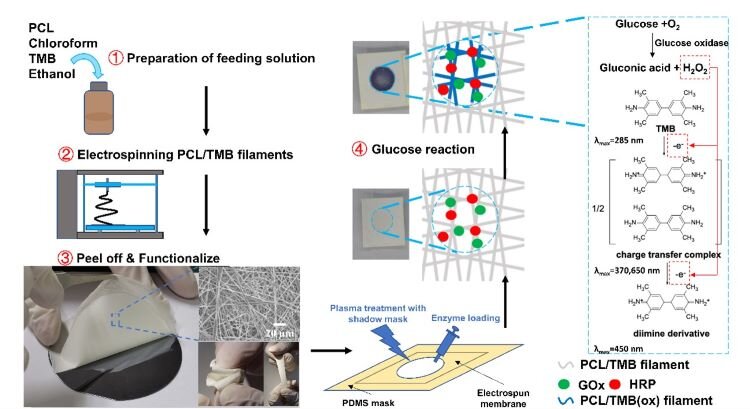Summary
In this research, a new polymer substrate for glucose colorimetric sensing was developed with electrospun polycaprolactone (PCL) and 3,3',5',5'-tetramethylbenzidine (TMB) hybrid micro/nanofibers. Biodegradable polymer PCL and chromogen TMB were combined in electrospinning process so that fibers consisted with PCL and TMB with diameters ranging from several hundreds of nanometers to several micrometers were achieved. With the piling up of micro/nanofibers, a flexible substrate with porous inner structure was formed up. After air-plasma treatment and loading of enzymes for colorimetric reaction, the substrate could be used for colorimetric assay. Compared to conventional paper-based sensing substrates, the electrospun substrate achieved better immobilization of chromogen so that a higher sensitivity. Also, the morphology of electrospun substrate could be tuned to meet potential further sensing requirements.

Background of the research
Paper-based sensing substrates are conventionally used for point-of -care test due to their availability and liquid absorption by capillary force. However, the inner morphology and mechanical properties cannot be easily tuned to meet the specific requirements of colorimetric sensors, including liquid capacity and reagent immobilization.
Description of research
As an alternative to paper materials, biodegradable polymeric membranes made of electrospun polycaprolactone (PCL) fibers can provide various tunable properties related to fiber diameter and pore size. Also, the chromogen TMB was combined into the feeding solution so that hybrid micro/nanofiber consisted with PCL and TMB were achieved, leading to a more stable chromogen immobilization.
Expected future
A new type of point-of-care device could be achieved when combining the newly fabricated electrospun sensing substrate with microneedles array patches (MAPs). As lots of biomarkers exists in interstitial fluid (ISF), bioassay could be achieved when ISF is extracted with MAPs and directly travels into electrospun sensing substrate. The flexible substrate indicates good fitting onto skin surface and omission of liquid transport process enhances the usability as a point-of-care device.
The article, "Fabrication of an electrospun polycaprolactone substrate for colorimetric bioassays" was published in Biomedical Microdevices at DOI: 10.1007/s10544-023-00673-z.
Research Contact
Kim Beomjoon, Professor
Institute of Industrial Science, the University of Tokyo
Tel:+81-3-5452-6224
E-mail: bjoonkim (Please add "@iis.u-tokyo.ac.jp" to the end)
